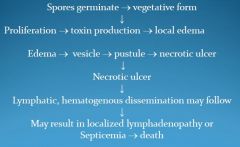![]()
![]()
![]()
Use LEFT and RIGHT arrow keys to navigate between flashcards;
Use UP and DOWN arrow keys to flip the card;
H to show hint;
A reads text to speech;
13 Cards in this Set
- Front
- Back
- 3rd side (hint)
|
What is the morphology and characteristics for Listera?
|
a. G+ rods, best motility at 22-25*C
b. catalase + c. facultative anaerobes d. non-spore froming e. replicates at temp of 4*C (cold enrichment) f. can tolerate temp at 65*C Note: can be killed by short time high temp pasteurization. |
|
|
|
Where will you normally find Listeria?
|
a. ubiquitous saprophyte in soil, decaying vegetation, feces of many mammals.
b. can survive for months to years in soil, organic matter c. shed in feces of inapparent carrier and sick animals and humans. d. cattle and sheep major reservoirs e. found in improperly stored silage (pH >5.0) f. two pathogenic species: 1. L. monocytogenes (found in humans and animals) 2. L. ivanovii ( animals only) |
|
|
|
What is the mode of transmission for Listeria?
|
Animal exposure:
1. environment 2. contaminated feed Human exposure: 1. contaminated food products 2. contact with animals is a rare exposure. |
|
|
|
What are the virulence factors for Listera?
|
1. facultative intracellular organism
2. intestinal transloaciton via M cells or across epithelial cells. 3. internalins: interact with cell receptors (E-cadherin) facilitating cell entry a. escapes phagosome via listeriolysin O (LLO) b. proliferates within cell c. uses actin filaments of host cell to move from cell to cell, avoiding immune recognition. |
|
|
|
Whats the pathogenesis for listeria?
|

|
|
|
|
What are some of the clinical conditions caused by Listeria?
|
A. Ruminants:
a. visceral dz - hepatic abscesses (usually young animals) b. Neurologic dz (circling dz) c. Abortion B. Horse a. uncommon; any of above C. Dog and cat (uncommon) a. fever, GI, CNS sings D. Chinchillas, rabbits, guinea pigs a. visceral dz E. Food-brone zoonotic dz a. inapparent to GI signs, menigitis b. serious birth defects. |
Primarily pathogen of large animals
|
|
|
Who would you diagnose Listeria?
|
a. may take sample from brain, blood, liver, spleen, fetal membranes and tissues
b. G + c. no growth on MacConkey agar d. narrow zone of B-hemolysis in blood agar e. will grow at reduced temperatures. f. Catalase + g. + motility test at lower temp. |
|
|
|
Whats the morphology and characteristics for Bacillus?
|
a. large G+ spore forming rods
b. aerobic or facultative anaerobes c. catalase + d. Two pathogenic species: 1. B. cereus: cause food poisoning (human, dogs), rarely bovine abortion and mastitis. 2. B. anthracis: all mammals (Class I bioterrorism agent!!!) |
|
|
|
Where will you normally find Bacillus?
|
a. widespread distribution in soil, water, dust, and air.
b. spores persist for years in environment. (best with pH >6pH, organic matter present) |
|
|
|
Whats the mode of transmission for Bacillus anthracis?
|
A. Dermal (wounds, insect bites)
B. Ingestion (contaminated substances); tend to display symptoms that are most severe C. Inhalation D. mucous membrane exposure. |
|
|
|
What are the virulence factors found in Bacillus?
|
1. Plasmid pXO1 (exotoxin)
a. Edema factor (EF) b. Lethal factor (LF) c. protective agent (PA) 2. Plasmid pXO2 (polypeptide capsule) a. inhibits phagocytosis b. only foun don vegetative form (not on spore) 3. Exotoxin components a. A = active or enzymatic portion = EF or LF b. B = binding protein = PA c. PA plus EF = Edema toxin d. PA plus LF = Lethal toxin |
A. lethal factor = metalloproteinase
a. modulate innate and adaptive immune response * disrupts intracellular signaling * induces apoptosis in macrophages * impairs antigen presentation by dendritic cells * inhibits B and T cell activation * may induce apoptosis in vascular endothelial cells B. Edema factor = adenylate cyclase * increase cAMP resulting in altered electrolyte, fluid flow --> edema * may also disrupt cytokine networks that suppress host IR. |
|
|
Whats the pathogenesis (septicemia) for Bacillus anthracis?
|

|
|
|
|
Whats the pathogenesis of localized infection for Bacillus anthracis?
|

|
|

